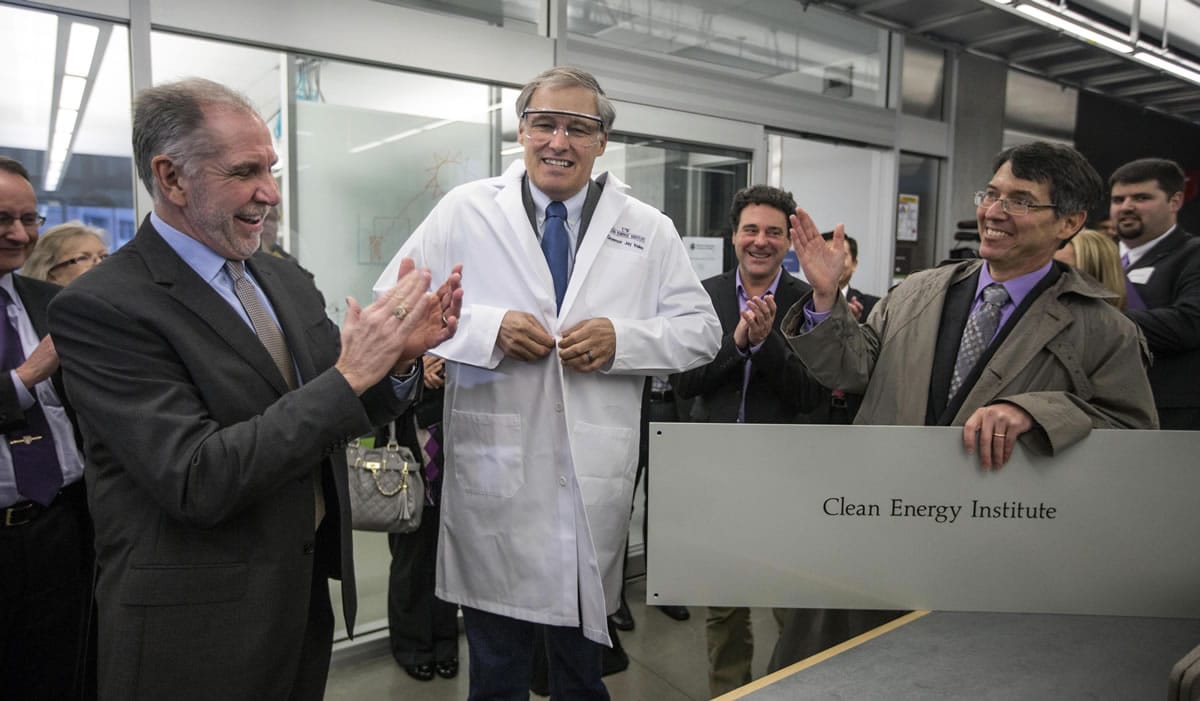SEATTLE — Plastic solar cells as easy to manufacture as Saran wrap.
Technologies that could make the electrical grid smarter and more efficient.
New types of industrial-scale batteries that could work with wind turbines or hydropower to store energy when it’s not needed, and release it when it is.
These innovations, and others, are among the new ideas being developed at the University of Washington’s new Clean Energy Institute, which was launched Thursday by Gov. Jay Inslee, a strong proponent of renewables.
The institute was created with $6 million in money from the Legislature that will support the institute for the next two years.
Its aim is to tie together work already underway by UW researchers around the campus, much of which is done in partnership with the federal Pacific Northwest National Labs. The science currently being conducted is funded by federal research grants.
Inslee acknowledged that naysayers don’t think the technology can deliver on its promises, but he said he’s a believer: Clean energy “is going to make tons of money and create thousands of jobs,” and Washington is in an excellent position to benefit from those innovations.
“We know the demand is going to be out there for clean-energy technology,” he said. “This is a real-life scenario, not just some pipe dream.”
The institute is focused on solar, electrical storage and smart-grid technology, but it will also examine large-scale environmental disruptions that could be caused by new sources of power, said Daniel Schwartz, director of the institute and the Boeing-Sutter professor of chemical engineering at the UW.
“All energy forms have an impact on the environment,” he said; for example, hydropower creates clean energy, but it causes the loss of salmon runs and remakes the landscape. “We have to be thoughtful about how we design energy systems.”
Besides thinking through the big-picture changes posed by new energy forms, the institute’s scientists will also work on cutting-edge science — creating new materials in the lab, using nanoscale molecules for solar cells and inventing new and better batteries.
Schwartz said he’s especially excited about a new form of solar cell being researched at the UW that’s made of copper, zinc, tin and sulfide — inexpensive and widely available materials.
In a short time, UW scientists have been able to dramatically improve the efficiency of solar cells made with those materials. Although, Schwartz said, it’s not the most efficient type of solar cell created, the low cost of the materials may allow it to one day leapfrog over other technologies.
In another project, UW scientists are creating solar “inks” that can be coated on surfaces to make low-cost solar cells. And, Schwartz said, the UW is working on solar cells made of plastic that are cheap to manufacture.
“We have, today, a world-class group of faculty that work in solar,” Schwartz said.
At the same time, the UW is also participating in a $178 million, five-year federal demonstration project in five Western states to see if smart-grid technologies can save significant amounts of electricity.
Five buildings on campus have been equipped with energy control systems that can “talk” to the regional power system, adjusting the building’s electricity use to the predicted cost of power. In its first year, the program has saved the UW $312,000.
K.C. Golden, a senior policy adviser with the nonprofit Climate Solutions, said he thinks the new institute’s research agenda is “pretty carefully targeted to things I think are very important.”



